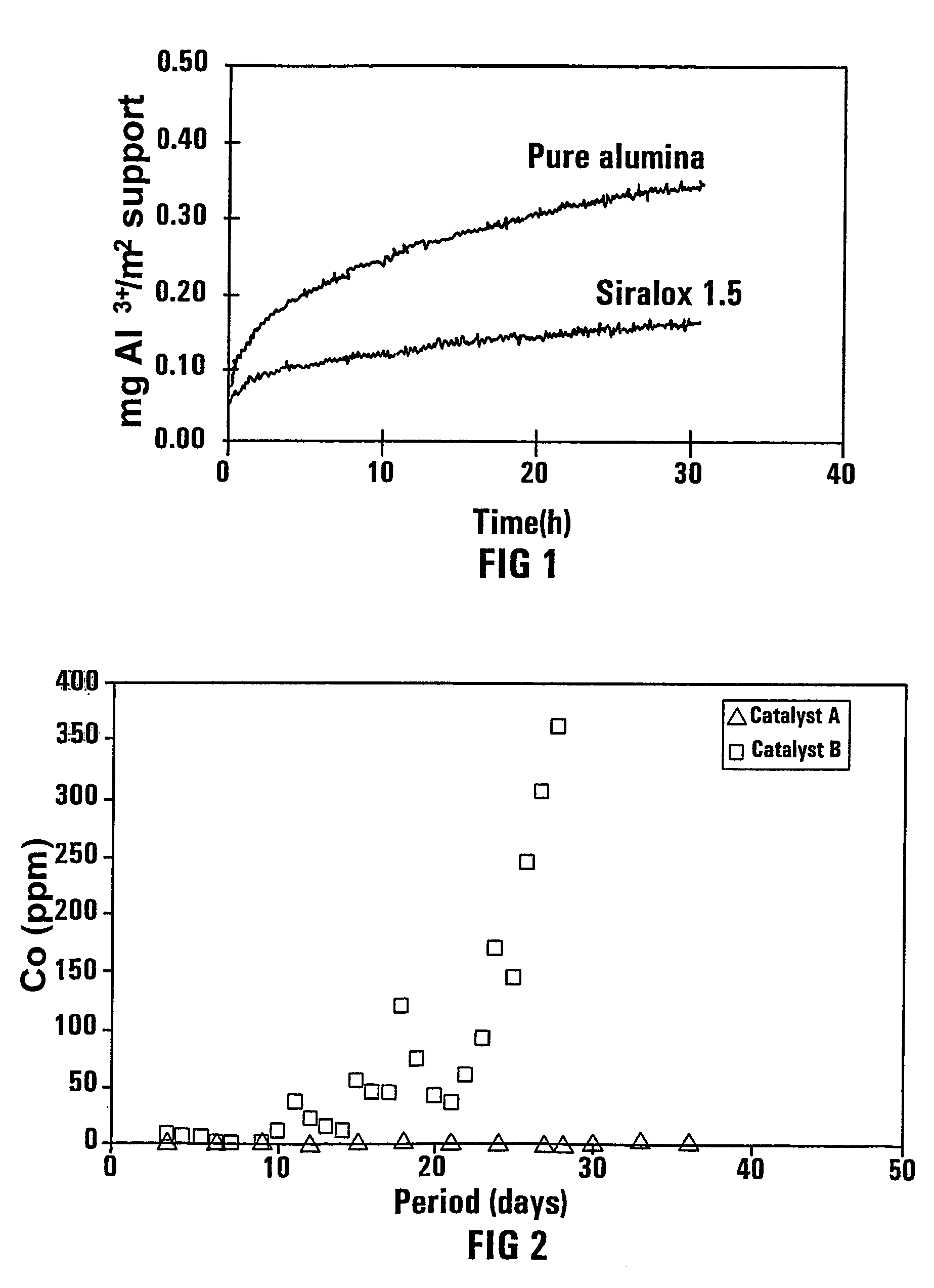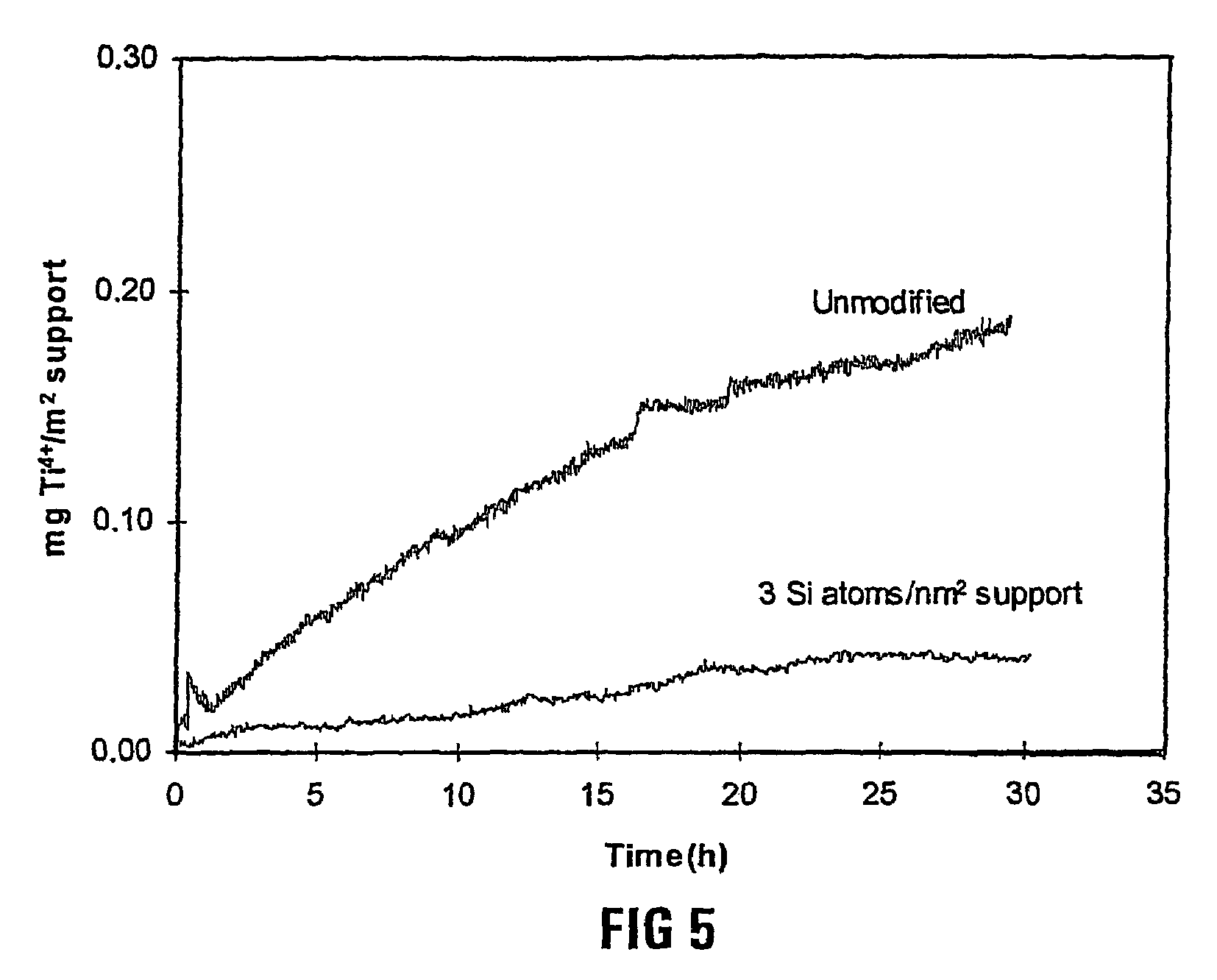Production of fischer-tropsch synthesis produced wax
a technology of fischer-tropsch synthesis and wax, which is applied in the direction of hydrocarbon oil treatment, liquid hydrocarbon mixture production, oxygen-containing compound preparation, etc., can solve the problem of additional processing steps required to modify the already pre-shaped catalyst support, and achieve the effect of increasing the inertness of the catalyst support and high cos
- Summary
- Abstract
- Description
- Claims
- Application Information
AI Technical Summary
Benefits of technology
Problems solved by technology
Method used
Image
Examples
example 1
[0027]In the example, two catalyst supports, and supported cobalt slurry phase Fischer-Tropsch synthesis catalysts obtained therefrom, are compared:
Puralox Catalyst
[0028]support: This catalyst support is that obtainable under the trademark Puralox SCCa 2 / 150 from SASOL Germany GmbH of Üb erseering 40, 22297, Hamburg, Germany. It is a pure gamma-alumina support, and is prepared by calcination of boehmite (AlO(OH)) at 750° C.
Siralox 1.5 Catalyst[0029]support: A successful catalyst support was prepared by hydrolyzing an aluminium alkoxide, obtained from the alkoxide process eg the Ziegler ALFOL process or the Sasol Chemie (formerly Condea) “o n-purpose” proprietary process as described in German Patent No. DE 3244972, at 90° C. Thereafter, a dilute solution of orthosilicic acid was added to the stirred mixture. This slurry was then spray dried at 300° C. to 600° C. to obtain the trademark product: Siral, which was tailored through calcination at between 600° C. and 1100° C., to obtain ...
example 2
[0046]The following modified or successful alumina supports were prepared by Sasol Germany GmbH of Üb erseering 40, 22297, Hamburg, Germany by doping of an alumina precursor (boehmite, ie AlO(OH)) before spraydrying (shaping). The modified supports were then calcined in a furnace at 750° C.:[0047]Modified support A: doped with 1.5 m % WO3.[0048]Modified support B: doped with a mixture of 1.5 m % TiO2 and 1.5 m % SiO2.[0049]Modified support C: doped with 1.5 m % BaO.[0050]Modified support D: doped with 4 m % Ce.
[0051]Conductivity measurements were performed on these samples under similar conditions as described in Example 1. The results are shown in FIG. 3, is clearly demonstrating that the modification of alumina, as a catalyst support, with W, a mixture of Ti and Si, Ba and Ce effects an alumina dissolution suppression similar to that of Si as a proved successful alumina support modifier.
example 3
[0052]The more preferred catalyst supports for cobalt based Fischer-Tropsch synthesis catalysts are alumina, titania, magnesium oxide and zinc oxide.
[0053]Particulate titanium dioxide (Degussa P25 (trademark)) support was spraydried and calcined for 16 hours at 650° C. The support had a surface area of 45 m2 / g. A magnesium oxide support, as supplied by MERCK, had a surface area of 88 m2 / g. Zinc oxide pellets, as supplied by Süd Chemie, were crushed and sieved to obtain a fraction between 38 and 150 μm. The resultant zinc oxide support had a surface area of 50 m2 / g.
[0054]The dissolution profiles of these supports were determined, and are shown in FIG. 4.
[0055]MgO and ZnO completely dissolved in the aqueous / acidic solution during the dissolution test, as indicated by the levelling off of the dissolution profile after 1 hour on-line. Both conductivity solutions after the test did not contain any solid residue and the solutions were clear. The TiO2 catalyst support only partially dissol...
PUM
| Property | Measurement | Unit |
|---|---|---|
| temperature | aaaaa | aaaaa |
| temperature | aaaaa | aaaaa |
| pressure | aaaaa | aaaaa |
Abstract
Description
Claims
Application Information
 Login to View More
Login to View More - R&D
- Intellectual Property
- Life Sciences
- Materials
- Tech Scout
- Unparalleled Data Quality
- Higher Quality Content
- 60% Fewer Hallucinations
Browse by: Latest US Patents, China's latest patents, Technical Efficacy Thesaurus, Application Domain, Technology Topic, Popular Technical Reports.
© 2025 PatSnap. All rights reserved.Legal|Privacy policy|Modern Slavery Act Transparency Statement|Sitemap|About US| Contact US: help@patsnap.com



